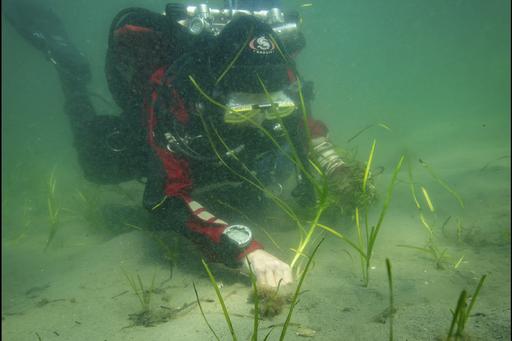Last year, 80,000 eelgrass shoots were planted in a shallow bay at Lilla Askerön on the Swedish west coast. When the researchers inspected the area in September, they were thrilled to discover that the number of plants had increased more than tenfold.
"This is the first time the sand capping method has been tested on a large scale with successful results. It shows that it's possible to restore eelgrass meadows, even where conditions are difficult and our usual methods don't work," says Per Moksnes, researcher at the University of Gothenburg.
The number of eelgrass meadows in southern Bohuslän has declined severely in recent decades; in many places they have disappeared completely. Therefore, researchers from the University of Gothenburg, together with the County Administrative Board of Västra Götaland, have now tested sand capping as a method for restoring eelgrass in a shallow bay at Lilla Askerön.
Last spring, a total of 1,800 tons of coarse sand was spread over a 10,000-square-metre area in the bay to give support to the shoots. In the summer, 80,000 shoots of eelgrass were subsequently planted by hand in the sand-covered area to restore eelgrass to the bay.
"By spreading out sand before planting shoots, we have created new conditions in an area where the water easily became too turbid for the eelgrass to survive. Sand capping is a new method in Sweden, and therefore it's really exciting to see that the eelgrass has grown so much," says Beatrice Alenius, marine biologist and project manager at the County Administrative Board in Västra Götaland.
Surprisingly good results
The first follow-up in December last year was promising. By then, the number of shoots in the area had doubled. When the researchers returned this year in September, they were anxious. They know by experience that wintertime is a critical period for eelgrass meadows. To their joy, they were met by a flourishing eelgrass meadow. The number of plants in the area had increased from 80,000 to 860,000.
"It was a surprisingly good outcome. It's likely we've passed a tipping point, where the eelgrass now contributes to the reduction of sediment turbidity and improvement of light conditions, and that the eelgrass meadow could continue to spread," says Per Moksnes, researcher at the Department for Marine Sciences.

Important to protect existing meadows
Eelgrass meadows play an important role in the ecosystem. The plant roots bind sediment together, preventing erosion and turbidity. They are also important for biodiversity. During the researchers' visit in September, they noticed that the meadow was teeming with crabs, sea anemones, fish, and other marine animals in quantities similar to a natural eelgrass meadow.
The research group Zorro has been working with the restoration of eelgrass meadows for ten years. This is the first time they have tested the sand capping method.
"We are pleased with the fact that sand capping seems to be working as a restoration method. But it's important to remember that it's both expensive, and also has a great risk of failure. Therefore, it's both cheaper and better to protect present eelgrass meadows, than to restore them," says Per Moksnes.
The restoration is part of a four-year project managed by the County Administrative Board in Västra Götaland, in collaboration with the University of Gothenburg. The project is financed by the European Maritime and Fisheries Fund, and the Swedish Agency for Marine and Water Management.
Text: Karl-Johan Nylén
Translation to English: Annika Wall






